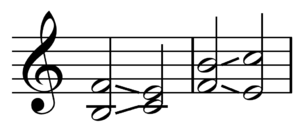Resolution (music)


Resolution in western tonal music theory is the move of a note or chord from dissonance (an unstable sound) to a consonance (a more final or stable sounding one).
Dissonance, resolution, and suspense can be used to create musical interest. Where a melody or chordal pattern is expected to resolve to a certain note or chord, a different but similarly suitable note can be resolved to instead, creating an interesting and unexpected sound. For example, the deceptive cadence.
Basis
[edit]A dissonance has its resolution when it moves to a consonance. When a resolution is delayed or is accomplished in surprising ways—when the composer plays with our sense of expectation—a feeling of drama or suspense is created.
— Roger Kamien (2008), p.41[2]
![{
\override Score.SpacingSpanner.strict-note-spacing = ##t
\set Score.proportionalNotationDuration = #(ly:make-moment 1/12)
\new PianoStaff <<
\new Staff <<
\relative c' {
\clef treble \key bes \major \time 2/4
r8 <es a>-.\p <d bes'>-.[ <c' es a>-.] <bes d bes'>-.\ff r
}
>>
\new Staff <<
\new Voice \relative c {
\clef bass \key bes \major \time 2/4
\stemUp <d bes'>8 \stemNeutral <f c'>-.[_\markup { \concat { "V" \raise #1 \small "7" \hspace #1.5 "I" \hspace #2 "V" \raise #1 \small "7" \hspace #1.4 "I" } }
bes-.] <f, f'>-. <bes, bes'>-. r \bar "|."
}
\new Voice \relative c, {
\clef bass \key bes \major \time 2/4
\stemDown bes8
}
>>
>> }](http://upload.wikimedia.org/score/n/d/ndqlm05zdm1icea67pifbnfmxnc8yo3/ndqlm05z.png)
Resolution has a strong basis in tonal music, since atonal music generally contains a more constant level of dissonance and lacks a tonal center to which to resolve.
The concept of "resolution", and the degree to which resolution is "expected", is contextual as to culture and historical period. In a classical piece of the Baroque period, for example, an added sixth chord (made up of the notes C, E, G and A, for example) has a very strong need to resolve, while in a more modern work, that need is less strong - in the context of a pop or jazz piece, such a chord could comfortably end a piece and have no particular need to resolve.
Example
[edit]An example of a single dissonant note which requires resolution would be, for instance, an F during a C major chord, C–E–G, which creates a dissonance with both E and G and may resolve to either, though more usually to E (the closer pitch). This is an example of a suspended chord. In reference to chords and progressions for example, a phrase ending with the following cadence IV–V, a half cadence, does not have a high degree of resolution. However, if this cadence were changed to (IV–)V–I, an authentic cadence, it would resolve much more strongly by ending on the tonic I chord.
See also
[edit]References
[edit]- ^ Benjamin, Horvit, and Nelson (2008). Techniques and Materials of Music, p.46. ISBN 0-495-50054-2.
- ^ Kamien, Roger (2008). Music: An Appreciation, 6th Brief Edition, p.41. ISBN 978-0-07-340134-8.
- ^ Forte, Allen (1979). Tonal Harmony in Concept & Practice, p. 145. Third edition. ISBN 0-03-020756-8.

